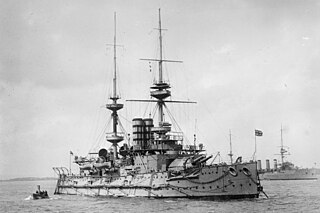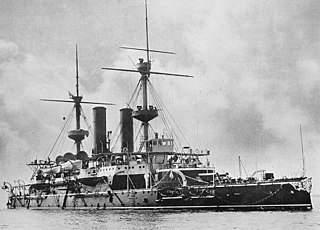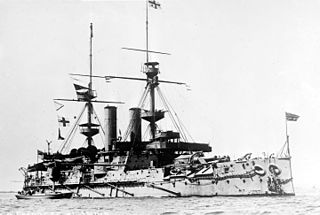
The King Edward VII class was a class of eight pre-dreadnought battleships launched by the Royal Navy between 1903 and 1905. The class comprised King Edward VII, the lead ship, Commonwealth, Hindustan, Britannia, Dominion, New Zealand, Africa, and Hibernia. They marked the first major development of the basic pre-dreadnought type that had been developed with the Majestic type of the mid-1890s, all of which had been designed by the Director of Naval Construction, William Henry White, with the primary innovation being the adoption of a heavy secondary battery of four 9.2-inch (234 mm) guns to supplement the standard main battery of four 12 in (305 mm) guns. The King Edward VIIs were among the last pre-dreadnoughts built for the Royal Navy before the construction and launch of the revolutionary battleship HMS Dreadnought in 1906, which immediately rendered them obsolescent.

The Majestic class of nine pre-dreadnought battleships were built for the Royal Navy in the mid-1890s under the Spencer Programme, named after the First Lord of the Admiralty, John Poyntz Spencer. With nine units commissioned, they were the most numerous class of battleships. The nine ships, HMS Majestic, Caesar, Hannibal, Illustrious, Jupiter, Magnificent, Mars, Prince George, and Victorious, were built between 1894 and 1898 as part of a programme to strengthen the Royal Navy versus its two traditional rivals, France and Russia. This continued the naval re-armament initiatives begun by the Naval Defence Act 1889.

The Revenge class, sometimes referred to as the Royal Sovereign class or the R class, consisted of five Dreadnought battleships built for the Royal Navy in the 1910s. All of the ships were completed to see service during the First World War. There were originally to have been eight of the class, but two were later redesigned, becoming the Renown-class battlecruisers, while the other, which was to have been named HMS Resistance, was cancelled outright. The design was based on that of the preceding Queen Elizabeth class, but with reductions in size and speed to make them more economical to build.

HMS Revenge was the lead ship of five Revenge-class super-dreadnought battleships built for the Royal Navy during the First World War in the mid-1910s. The ships were developments of the Queen Elizabeth-class battleships, with reductions in size and speed to offset increases in armour protection whilst retaining the same main battery of eight 15-inch (381 mm) guns. She was laid down in 1913, launched in 1915 and commissioned in February 1916, early enough to be worked up to see action with the Grand Fleet at the Battle of Jutland in May that year. During the engagement, she engaged German battlecruisers, damaging two of them before being forced to turn away to avoid torpedoes that damaged her squadron flagship and caused the squadron to lose contact with the rest of the fleet. Revenge emerged from the battle unscathed, but she saw no further action during the war, as the British and German fleets turned to more cautious strategies owing to the risk of submarines and naval mines.

HMS Royal Sovereign was a Revenge-class battleship of the Royal Navy displacing 29,970 long tons (30,450 t) and armed with eight 15-inch (381 mm) guns in four twin-gun turrets. She was laid down in January 1914 and launched in April 1915; she was completed in May 1916, but was not ready for service in time to participate in the Battle of Jutland at the end of the month. She served with the Grand Fleet for the remainder of the First World War, but did not see action. In the early 1930s, she was assigned to the Mediterranean Fleet and based in Malta.

HMS Resolution was one of five Revenge-class battleships built for the Royal Navy during the First World War. Completed in December 1916, Resolution saw no combat during the war as both the British and German fleets adopted a more cautious strategy after the Battle of Jutland in May owing to the increasing threat of naval mines and submarines.

The Renown class consisted of two battlecruisers built during the First World War for the Royal Navy. They were originally laid down as improved versions of the Revenge-class battleships, but their construction was suspended on the outbreak of war on the grounds they would not be ready in a timely manner. Admiral Lord Fisher, upon becoming First Sea Lord, gained approval to restart their construction as battlecruisers that could be built and enter service quickly. The Director of Naval Construction (DNC), Eustace Tennyson-D'Eyncourt, quickly produced an entirely new design to meet Admiral Lord Fisher's requirements and the builders agreed to deliver the ships in 15 months. They did not quite meet that ambitious goal, but they were delivered a few months after the Battle of Jutland in 1916. They were the world's fastest capital ships upon their commissioning.

HMS Hood was a modified Royal Sovereign-class pre-dreadnought battleship built for the Royal Navy in the early 1890s. She differed from the other ships of the class in that she had cylindrical gun turrets instead of barbettes and a lower freeboard. She served most of her active career in the Mediterranean Sea, where her low freeboard was less of a disadvantage. The ship was placed in reserve in 1907 and later became the receiving ship at Queenstown, Ireland. Hood was used in the development of anti-torpedo bulges in 1913 and was scuttled in late 1914 to act as a blockship across the southern entrance of Portland Harbour after the start of World War I.

The Canopus class was a group of six pre-dreadnought battleships of the British Royal Navy built in the late 1890s. The ships were designed by the Director of Naval Construction, William White, for use on the China Station. The class comprised Canopus, the lead ship, and Glory, Albion, Ocean, Goliath, and Vengeance. The class was armed with a main battery of four BL 12 inch Mk VIII naval guns and a secondary battery of twelve QF 6-inch guns. Compared to the preceding Majestic-class battleships, the Canopus class was smaller, faster, and less heavily armoured, though they adopted new, stronger Krupp armour, which was more effective than the Harvey steel used in the Majestics. In addition to the Krupp steel, the ships also adopted several other changes, including water-tube boilers, in-line funnels, and a full-length armoured belt.

HMS Resolution was a Royal Sovereign-class pre-dreadnought battleship of the Royal Navy. The ship was built by Palmers Shipbuilding and Iron Company, starting with her keel laying in June 1890. She was launched in May 1892 and, after completing trials, was commissioned into the Channel Squadron the following December. She was armed with a main battery of four 13.5-inch guns and a secondary battery of ten 6-inch guns. The ship had a top speed of 16.5 knots.

HMS Revenge was one of seven Royal Sovereign-class pre-dreadnought battleships built for the Royal Navy during the 1890s. She spent much of her early career as a flagship for the Flying Squadron and in the Mediterranean, Home and Channel Fleets. Revenge was assigned to the International Squadron blockading Crete during the 1897–1898 revolt there against the Ottoman Empire. She was placed in reserve upon her return home in 1900, and was then briefly assigned as a coast guard ship before she joined the Home Fleet in 1902. The ship became a gunnery training ship in 1906 until she was paid off in 1913.

HMS Repulse was one of seven Royal Sovereign-class pre-dreadnought battleships built for the Royal Navy in the 1890s. Assigned to the Channel Fleet, where she often served as a flagship, after commissioning in 1894, the ship participated in a series of annual manoeuvres, and the Queen Victoria's Diamond Jubilee Fleet Review during the rest of the decade. Repulse was transferred to the Mediterranean Fleet in 1902 and remained there until December 1903, when she returned home for an extensive refit. After its completion in 1905, Repulse was assigned to the Reserve Fleet until she was sold for scrap in 1911.

The Swiftsure class was a group of two British pre-dreadnought battleships. Originally ordered by Chile as the Constitución class during a period of high tension with Argentina, they were intended to defeat a pair of armoured cruisers ordered by the latter country and were optimized for this role. This meant that they were smaller and more lightly armed than most battleships of the time. They were purchased by the United Kingdom in 1903 prior to their completion to prevent their purchase by the Russian Empire as tensions were rising between them and the Japanese Empire, a British ally. Completed the following year, Swiftsure and Triumph had roughly similar careers for the first decade of their service careers. They were initially assigned to the Home Fleet and Channel Fleets before being transferred to the Mediterranean Fleet in 1909. Both ships rejoined the Home Fleet in 1912 and were transferred abroad in 1913, Swiftsure to the East Indies Station as its flagship, and Triumph to the China Station.

HMS Royal Sovereign was the lead ship of the seven ships in her class of pre-dreadnought battleships built for the Royal Navy in the 1890s. The ship was commissioned in 1892 and served as the flagship of the Channel Fleet for the next five years. She was transferred to the Mediterranean Fleet in 1897 and returned home in 1902, and was briefly assigned as a coast guard ship before she began a lengthy refit in 1903–1904. Royal Sovereign was reduced to reserve in 1905 and was taken out of service in 1909. The ship was sold for scrap four years later and subsequently broken up in Italy.

HMS Empress of India was one of seven Royal Sovereign-class pre-dreadnought battleships built for the Royal Navy during the 1890s. The ship was commissioned in 1893 and served as the flagship of the second-in-command of the Channel Fleet for two years. She was transferred to the Mediterranean Fleet in 1897, during which time Empress of India was assigned to the International Squadron blockading Crete during the uprising there. She returned home in 1901 and was briefly assigned as a coast guard ship in Ireland before she became the second flagship of the Home Fleet. The ship was reduced to reserve in 1905 and accidentally collided with the submarine HMS A10 the following year. Empress of India was taken out of service in early 1912 and accidentally struck a German sailing ship while under tow. She was sunk as a target ship in 1913.

HMS Ramillies was a Royal Sovereign-class pre-dreadnought battleship of the Royal Navy, named after the Battle of Ramillies. The ship was built by J. & G. Thompson at Clydebank, starting with her keel laying in August 1890. She was launched in March 1892 and commissioned into the Mediterranean Fleet as flagship the following October. She was armed with a main battery of four 13.5-inch guns and a secondary battery of ten 6-inch guns. The ship had a top speed of 16.5 knots.

HMS Royal Oak was one of seven Royal Sovereign-class pre-dreadnought battleships built for the Royal Navy during the 1890s. Upon her completion in 1894, she was initially placed in reserve until mobilised in 1896 for service with the Flying Squadron. After returning briefly to reserve, the ship was assigned the following year to the Mediterranean Fleet. Royal Oak remained there until 1902 when she returned home; after a refit, the ship was assigned to the Home Fleet, where she served as the flagship of the fleet's second-in-command in 1904–05. Royal Oak was then reduced to reserve until she was taken out of service in 1911. The ship was sold for scrap in early 1914.

The Centurion-class battleships were a pair of pre-dreadnought battleships built for the Royal Navy in the 1890s. They were rated as second-class battleships because they were less heavily armed and armoured than the first-class battleships. They were designed for service abroad and were given higher speed and longer range to counter the armoured cruisers then being built as commerce raiders.

HMS Renown was a second-class predreadnought battleship built for the Royal Navy in the early 1890s. Intended to command cruiser squadrons operating on foreign stations, the ship served as the flagship of the North America and West Indies Station and the Mediterranean Fleet early in her career. Becoming obsolete as cruiser speeds increased, Renown became a royal yacht and had all of her secondary armament removed to make her more suitable for such duties. She became a stoker's training ship in 1909 and was listed for disposal in 1913. The ship was sold for scrap in early 1914.






















